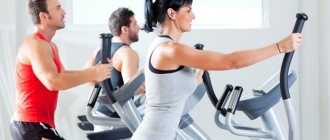An elliptical trainer - also known as an ellipse or an orbitrack - can be recommended for those for whom running and jumping are prohibited due to large excess weight. It forces the muscles to work without overloading the joints and without excessive axial pressure on the spine. “During exercise on the ellipse, our legs move along a unique trajectory,” explains Alexander Kolesov, head of the rehabilitation department of the MEDSI Clinical Diagnostic Center on Krasnaya Presnya, sports medicine doctor, physical therapy doctor, manual therapy doctor . - It is similar to running, cycling, skiing and climbing stairs, but the joints of the legs receive minimal stress. The simulator is good for people of different ages and physical fitness; it is often used in rehabilitation after injuries to the musculoskeletal system.”
What does the ellipse train?
It helps burn calories and strengthen the muscles of the legs, arms and whole body. “I very often recommend regular training on the elliptical to my patients,” says Alexander Kolesov, “as it not only provides cardio exercise, but also allows you to strengthen the muscles of the back, legs and arms. In addition, the ellipse reinforces the walking pattern - one of the most important reflex interactions, which is often lost or disrupted in modern humans due to an inactive lifestyle. Here, the benefits of an elliptical trainer can hardly be overestimated. Exercises on it do not put a shock load on the joints, which is important for people with joint and spine problems. Often, when the muscles are sufficiently strengthened, they allow you to gradually move on even to jogging.”
In what cases of health problems is the ellipse used?
Let's start with the ability of the ellipse to have a positive effect on blood circulation. Diseases such as arthritis, osteochondrosis, arthrosis or pinched nerves arise precisely due to insufficient blood circulation. A sedentary lifestyle can similarly have detrimental health effects in the form of salt deposits. It is for this reason that the elliptical trainer is actively used to treat these diseases - it will put a load on the whole body at once, without having a detrimental effect on the joints.
For joint fractures (ankle and hip), an ellipse is often prescribed as rehabilitation; by the way, for spinal injuries it is also prescribed. The reason for this is the ability to influence the muscles, bypassing the load on the joints and spine.
For women who have had a difficult birth or have undergone surgery on the pelvic organs, the ellipse will also be useful. The athlete will be able to maintain muscle tone without overstraining those parts of the body that definitely do not need extra stress at a particular moment.
Fitness Place is the territory of a healthy lifestyle. On our marketplace, the buyer will be able to choose his own elliptical trainer, which will ideally suit his needs and financial capabilities.
How to exercise on an elliptical trainer?
If you work out in a gym, you should consult a fitness instructor once. If you are buying an elliptical trainer for home, use the advice of our expert.
“Pay attention to the following factors,” explains Alexander Kolesov.
- Distance (width) between pedals. Too much width makes movement uncomfortable and puts unnecessary stress on the knee joints. It is important that the knee and ankle joints are strictly under the hips of the practitioner.
- Step length. This parameter, set by the manufacturer, determines how much “swing” the elliptical pedals can move back and forth. The step depends on the height of the practitioner: the taller the person, the longer it is.
- Load system . Preferable is electromagnetic, which allows you to more accurately regulate the load level.
- Flywheel location . The front one is considered better, with it the pedal stroke will be more comfortable.
- Flywheel weight. The larger it is, the smoother the pedals move.
How to properly exercise on an elliptical trainer to lose weight?
To burn fat, it is important to follow standard cardio principles. It should last from 30 to 60 minutes and take place at a pulse of 60-80% of the maximum heart rate (MHR). MHR is calculated depending on your age. The simplest calculation method is 220 minus age. The resulting figure must be multiplied by 0.8 - you will get a figure above which your heart rate should not rise during training. And the figure that is obtained by multiplying the MHR by 0.6 is your minimum recommended heart rate.
To monitor your heart rate during exercise, it is best to use a sports watch or fitness bracelet with a heart rate sensor built into the watch or in the form of a chest strap. Many ellipsoids have fixed handles with metal platforms that measure your heart rate. You can use them, but there is one caveat. When you hold on to these handles, your heart rate will not be measured immediately. At the same time, your arms do not work, therefore, the pulse decreases, and the load on the upper shoulder girdle and body decreases. Make allowances for this fact.
Don't forget about safety precautions! Always hold the ellipse's movable handrails or fixed handles with both hands. Keep your feet fully planted on the pedals and do not let them hang down or lift your heels while walking. The knees are bent almost all the time; they do not straighten completely, only when the leg moves back.
The essence of training
Thanks to the elliptical trainer, the heart muscle is pumped, calories are burned, and a number of muscles are developed in the hips, arms, shoulders, abdomen, back, buttocks, legs, and hamstring tendons. Additionally, the vegetative-vascular and respiratory systems are involved.
Modern models are equipped with built-in computers with monitors that display basic information - heart rate, time, speed, calories, distance, and much more. etc. Based on reviews, these are the variations that those who lose weight prefer:
“This is convenient, since you can select a special program depending on the level of training and the loads that the trainee can withstand. This allows you to use the equipment at home.”
Long training
This is a basic exercise both for the purpose of losing weight and for increasing endurance and improving health. A trained person can carry out it for 1 hour 15 minutes - 1 hour 30 minutes, but if you are overweight, it is better to limit it to one hour. During a long workout, you move evenly, within the heart rate zone of 60-80% of MHR. Walking on the elliptical can be a little faster or slower, especially if you have an uphill program. But changes during long-term training always occur smoothly, insignificantly and are not the goal of the lesson at all. The main thing is to move evenly in the specified pulse zone.
If you want to diversify your workout and slightly change the load on your muscles, you can try different types of steps. But this is worth doing only if you are not a beginner and are sure that you will not get dizzy and everything is fine with coordination. Always grab the stationary handles first, then change your stride type. Do not use moving handrails.
- Steps back. Stop and start pedaling backwards. This will additionally load the back of the thigh and buttocks.
- Descent. Leaning on your hands, lean your body forward strongly, as if you were lying on the handlebars of a bicycle when descending. Your feet will push the pedals not only down, but also back. This will also give additional detail to the back of the thighs and lower buttocks.
- Half squat steps. Squat down slightly and walk without straightening your legs completely. This will work out all the thigh muscles well.
Thus, the benefits of interval cardio training:
- Losing weight in a short time (with moderate intensity training, getting rid of extra pounds can last a long time, depending on the characteristics of the body - from several months to a year or more; with interval training, this time is reduced by almost half);
- Saving time (calorie consumption is no less than during long-term training, while the training time is significantly reduced);
- Powerful endurance training (high intensity interval training trains the cardiovascular system well);
- A good addition to strength training (high-intensity exercises help athletes stay in shape and not lose muscle mass);
- Not boring workouts (for people who constantly do cardio exercises, the concept of “not boring” is one of the defining ones, since even reading books and watching programs on TV while running on a treadmill or doing an elliptical trainer can get very boring. Interval training does not allow you to relax during It is impossible to just read, talk on the phone or watch a movie, it is a process of complete immersion in the work of the body, which does not allow you to get bored).
Of course, interval training is not magic, but a heavy load on the heart, joints and muscles (read which muscles work on the elliptical trainer). They are not suitable for everyone, and therefore the disadvantages of interval training are listed below:
- Not suitable for beginners (high-intensity exercise assumes that the person has some experience in physical exercise, and the level of his endurance is not a minus sign. Before starting interval training, you need to prepare the body, this may take several weeks or months. The human heart should be able to withstand heavy loads without any problems, that is, pump blood very intensely.You need to make sure that you stay calm on the elliptical trainer or treadmill, and do not feel dizzy or other unpleasant sensations, otherwise there is a risk of severe overload, fainting, and even getting problems with heart);
- Inadmissible for people with heart problems (explanations are unnecessary here: for people with diseases of the cardiovascular system, high stress on the heart is simply contraindicated);
- Inadmissible for people with excessive weight and obesity (this point is directly dependent on the previous one: high-intensity exercise is contraindicated for people with critical weight due to the strong effect on the cardiovascular system);
- People with problematic joints and varicose veins should be careful about interval training. It is best to consult a doctor to make sure there are no or no contraindications (read how to properly train on an elliptical trainer).
Interval training on the elliptical trainer
This activity burns more calories. During it, work in the fat-burning pulse zone of 60-80% of the MHR and going into the power zone are abruptly replaced - up to approximately 85% of the maximum heart rate. This significantly increases the load on both the muscles and the heart. This activity is more effective, but requires more recovery time and can only be recommended to trained people.
Interval training is structured in different ways. Typically, the effort interval is 3-4 times shorter than the rest interval. For example, you add resistance to the machine or sharply increase your step frequency and work like this for 1 minute. Then walk for 3-4 minutes at a calmer rhythm, restoring your breathing.
For such a workout, you can use the built-in programs of the elliptical trainer. Choose those where you need to climb steep hills 3-4 times during the workout. Going up will raise your heart rate and put more strain on your muscles. The descent and movement on the plain will be a rest interval.
Model selection rules
When selecting an elliptical trainer for use at home, it is necessary to take into account the design features, which will allow you to exercise safely and comfortably. Particular attention is paid to the loads that the device can withstand. The athlete should not weigh more than the permissible limit. The optimal option is that a person’s weight should be 15 kg less.
The strength of equipment elements is an important indicator. If the student weighs more than 100 kg, preference should be given to stationary models rather than folding ones. Experts say that the load on the muscles is ensured by the smooth movement of the flywheel, so it must be heavy. The weight of the device affects stability. Reviews from those losing weight suggest that this makes sense. For example:
“I bought a folding elliptical trainer for home – small, compact, one might say, for women. I never had any problems during exercise, but my friend, who weighs 114 kg, turned over. Couldn’t bear his body weight (both laughter and sin).”
The pedal stride length is selected based on height and physical fitness. Trainers recommend that beginners and people of short stature use equipment with a stride length of no more than 40 cm. Those starting to lose weight are not advised to buy models that allow for changing the angle of the pedal.
How much do you need to do on the elliptical to lose weight?
If you are a beginner, then start by training 3 times a week for 30-40 minutes at low speed, minimal or light resistance. After 2-4 weeks, you can use the built-in training programs or manually increase the resistance.
After working out on the elliptical for 2-3 months, you can replace one of your long workouts per week with interval training. After 2-3 weeks, you can introduce another interval. If you feel good, then you can do interval training all 3 times a week. Typically the duration of such a lesson is 30-40 minutes.
Answers to frequently asked questions
1. What to look for when choosing an elliptical trainer: benefits or harm to health?
It is worth comparing both factors and paying attention to your well-being. A healthy person needs to remember the possible consequences, but for him the benefits of sports equipment are much more important. If a trainee has problems, it is important to review the contraindications and draw a conclusion: is it possible to take risks or is it better to change physical activity.
2. Can pregnant women exercise?
For women whose pregnancy is progressing well, the ellipse is not contraindicated. Before cardio training, consultation with a doctor is required - in some cases, pregnant women should absolutely not overload themselves.
3. How to train for beginners?
Beginners are recommended to walk for 20 minutes, warm up before using the orbitrek, and cool down after. The intensity should be low to medium. Weekly training increases by 5 minutes.
4. How long do you need to train to see results?
If you have a slim figure, half-hour approaches, 2-3 times a week, are sufficient. When losing weight, the duration increases to 45-60 minutes; cardio classes can be done every other day.
How much weight can you lose on an elliptical?
Training on the orbitrack is a full-fledged cardio exercise with strength elements for the whole body. So this exercise machine is quite enough to lose weight to your desired weight.
You only need to fulfill 2 conditions.
- The desired weight must be realistic. It is impossible to dream of a weight of 45 kg with a height of 180 cm. It is best to take your weight at 18-20 years old as a guide. If you are already over 40, add 3-5 kg to this figure.
- You should eat fewer calories than you burn! Spend, of course, not only in training, but also in everyday life. Typically, to lose weight you need to eat 1500-1800 kcal per day.
The normal rate of weight loss is about 0.5 kg per week. By training on the orbit track, many girls lose 0.8-1 kg per week.
Workout diary for losing weight: what to put in it?
Keeping a training diary in a notebook, in a file or in an application on your smartphone is a very useful thing. It disciplines and does not allow you to skip workouts, helps you see progress and plan further weight loss.
Write down in your diary which days of the week you will train and what exactly to do. You can take the program from our article or use the built-in program of the simulator - then indicate its number.
After your workout, record the time, average and maximum heart rate, and how many calories you burned. For intervals, indicate how many effort-rest cycles you completed. Note how you found the lesson - easy, hard, normal?
Also, once a week, write down your weight and waist and hip measurements in a diary. If your problem area is your legs, you can also measure the circumference of each hip separately.











